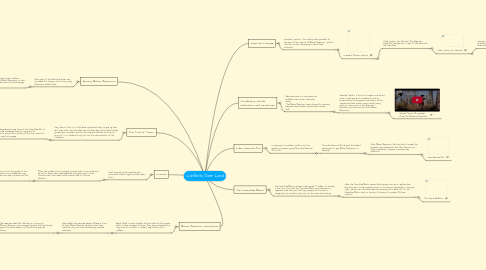
1. Moving Native Americans
1.1. Area west of the Mississippi River was unsuitable for farming, so not very many Americans settled there.
1.1.1. President Jackson and many other settlers wanted the land of the Native Americans, so they planned to relocate them west of the Mississippi River.
1.1.1.1. The Five Civilized Tribes
2. The Trail of Tears
2.1. Very few of the 17,000 Cherokee signed the treaty to give up their land. Even after the Cherokee set a written plea to the United States government, President Jackson sent General Winfield Scott and an army of 7,000 federal troops for the forced relocation of the Cherokee.
2.1.1. General Scott threatened to use force if the Cherokee did not vacate the area. He intimidated them by saying he had positioned troops all around the country so that they would not resist and they could not escape.
2.1.1.1. After realizing that resisting would only lead to their demise, the Cherokee surrendered and began the long journey west. The path that was taken has its place in history as the Trail of Tears, or known by the Cherokee as the Trail Where They Cried.
2.1.1.1.1. The Trail of Tears was a path of vicious and cruel weather that took the lives of thousands of Cherokee.
3. Osceola
3.1. Chief Osceola of the Seminoles led successful attacks against United States forts.
3.1.1. After the suffering of his people, Osceola tried to surrender but he and his family were then captured and imprisoned in South Carolina, which was were Chief Osceola died of a throat infection.
3.1.1.1. Although he led attacks on American forts, the people of the United States thought he was a good and honorable man. Due to the public opinion, Chief Osceola was given a funeral and full military honors.
3.1.1.1.1. Chief Osceola
4. Native American Resistance
4.1. Black Hawk, a Sauk chieftain, led the Sauk and Fox people back to their homeland of Illinois. They were slaughtered as they tried to run back to modern day Iowa by 4,500 soldiers.
4.1.1. What makes the Seminole people different from all other Native American groups is that they were the only ones that successfully resisted relocation.
4.1.1.1. The Seminoles allied with the Maroon, a group of African Americans who escaped slavery, and they fought against the white settlers of Florida with guerrilla tactics.
4.1.1.1.1. Although the Seminoles were able to stay in Florida, many had died in the fight and even more were forced to relocate west bound.
5. Indian Removal Act
5.1. In response to President Jackson and the settlers, Congress passed the Indian Removal Act in 1830.
5.1.1. The Indian Removal Act allowed the federal government to pay Native Americans to relocate.
5.1.1.1. Many Native Americans felt they had to accept the payment and relocated to the Indian Territory, an area created by Congress, in present-day Oklahoma.
5.1.1.1.1. Indian Removal Act
6. The Cherokee Nation
6.1. The Cherokee Nation refused to be moved. A number of treaties in the 1790s show that the Cherokee Nation saw Georgia as a separate state with laws that they respected. The view on respecting one another's laws was not the same with Georgia.
6.1.1. When the Cherokee Nation realized that Georgia was set on getting their land, they went to the Supreme Court. In the case of Worcester v. Georgia, Chief Justice John Marshall ruled that Georgia had to back off of the Cherokee Nation, much to the day of dismay of President Andrew Jackson.
6.1.1.1. The Cherokee Nation
7. Vocabulary Words, Definitions, and Sentences
7.1. Relocate-move to a new place and establish one's home or business there. "The Native Americans were forced to relocate because white settlers wanted their fertile land."
7.1.1. Guerrilla Tactics- a form of irregular warfare in which a small group of combatants such as armed civilians or irregulars use military tactics. "Guerilla warfare tactics were used by many nations in wars, such as the American Revolution and the removal of the Native Americans."
7.1.1.1. Guerilla Tactics; An Example From The American Revolution
8. Important People
8.1. President Jackson- The United States president at the time of the removal of Native Americans. Jackson was the one who mercilessly ordered their relocation.
8.1.1. President Andrew Jackson
8.1.1.1. Chief Justice John Marshall- The judge who ruled that Georgia had no right to interfere with the Cherokee.
8.1.1.1.1. Chief Justice John Marshall

